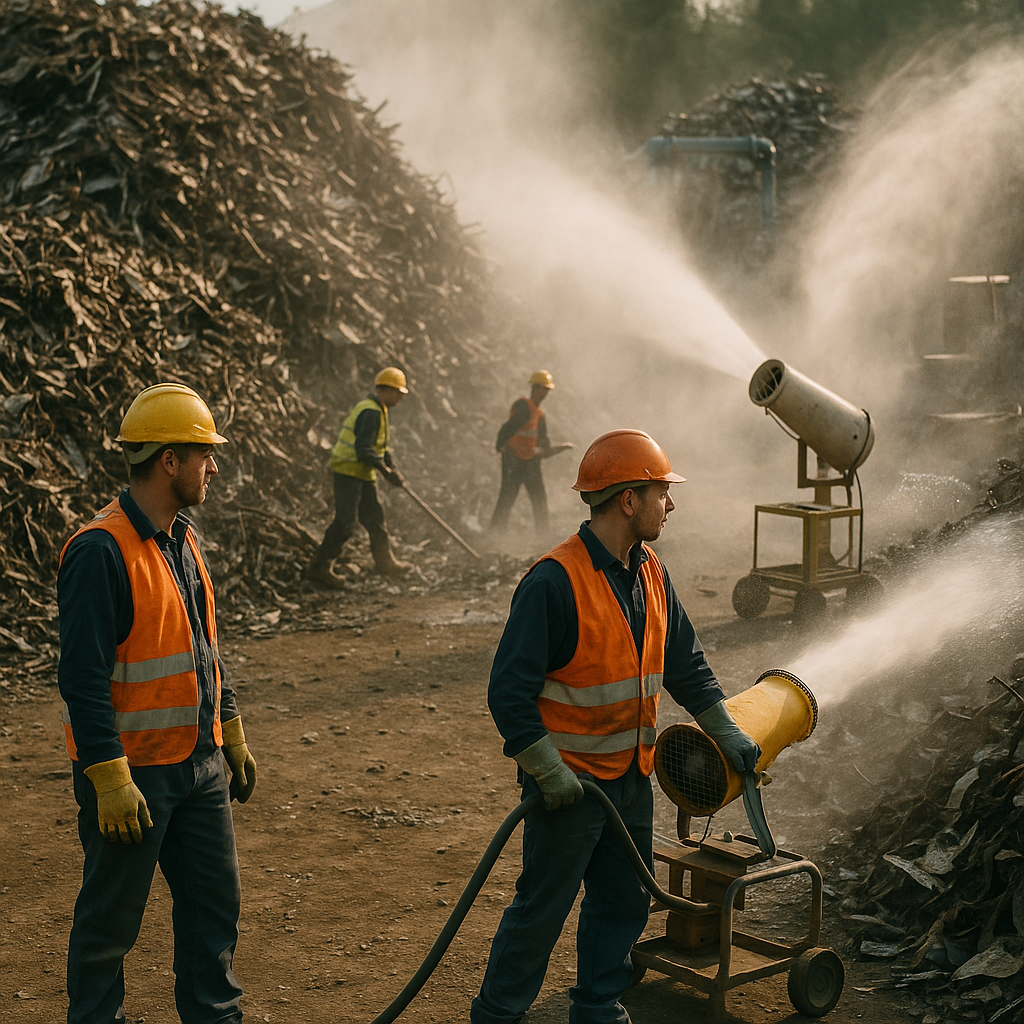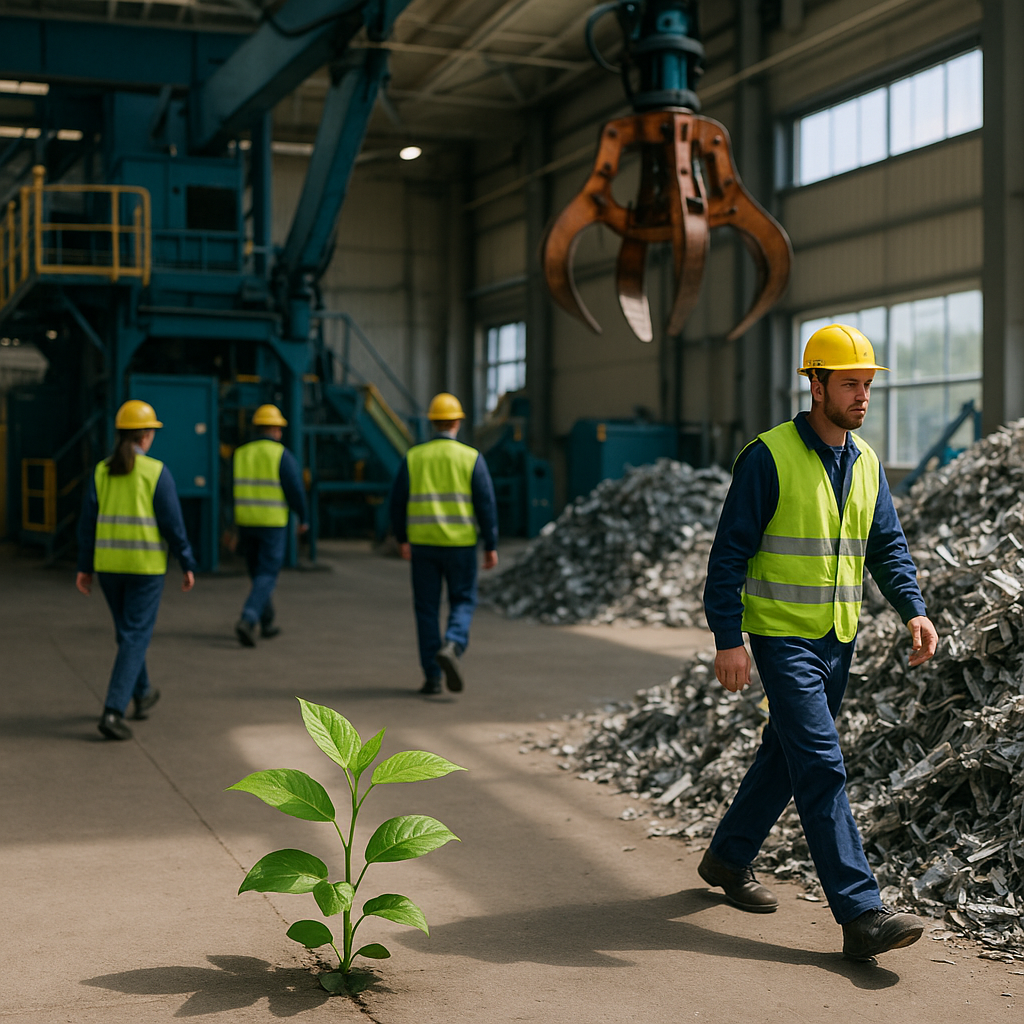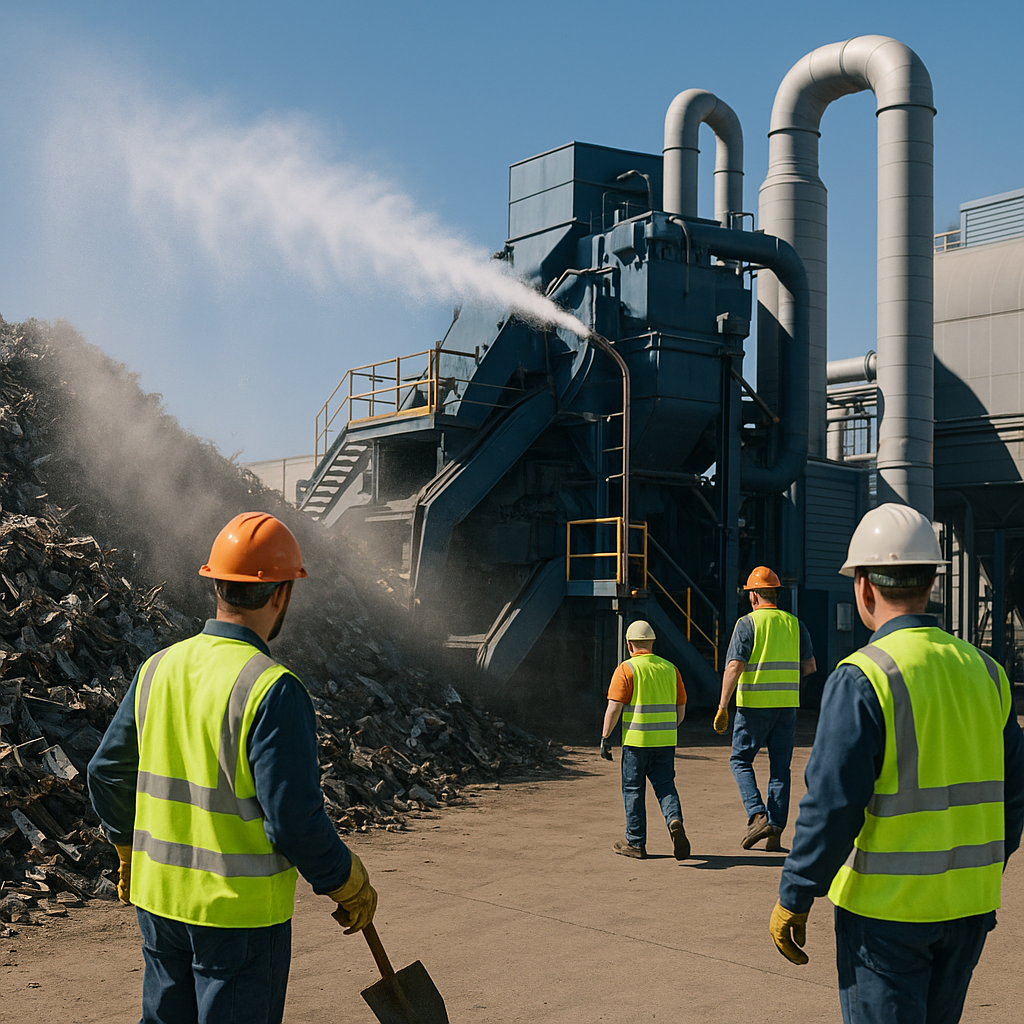5901 Botham Jean Blvd, Dallas, TX 75215
Dust Suppression Systems in Scrap Processing: A Quick Guide
October 15, 2025Dust suppression systems in scrap processing are specialized technologies designed to control and minimize airborne dust particles generated during the handling and processing of scrap materials. These systems are vital for maintaining air quality, protecting worker health, and ensuring facilities comply with increasingly strict environmental regulations.
Every day, scrap recycling facilities process tons of metal and other materials that produce significant amounts of dust. When scrap is unloaded, sorted, shredded, or stored, dust particles become airborne, some containing harmful substances like heavy metals, silica, and other toxic materials that pose serious health risks.
The scrap recycling industry faces unique challenges as operations often occur near residential areas. As communities expand into formerly isolated industrial zones, the need for effective dust control becomes more urgent. Modern dust suppression systems employ various methods to capture or prevent dust from becoming airborne, thus protecting both workers and nearby communities from potential exposure to harmful particles.
What Types of Dust Suppression Systems Are Used in Scrap Processing?

Scrap processing facilities generate significant amounts of dust during material handling, transportation, and processing operations. Effective dust suppression is vital for worker safety, environmental compliance, and operational efficiency. Numerous specialized systems are employed in the scrap recycling industry to tackle these challenges.
Atomized Mist Technology
Atomized mist systems are among the most effective dust control solutions in scrap processing. These systems generate millions of tiny water droplets (typically 50-200 microns) that capture airborne dust particles.
The fine mist travels with dust particles even in windy conditions, bringing them to the ground before they can escape facility boundaries. Unlike traditional water sprays, atomized mist uses significantly less water while providing superior dust capture.
Atomized mist systems can be deployed in various configurations:
- Mist cannons – Powerful fan-driven units that project mist across long distances, ideal for large processing areas or outdoor scrap piles.
- Mounted misting heads – Strategically placed around crushers, shredders, and material transfer points.
- Tower-mounted systems – Elevated installations that provide coverage over tall scrap piles and broad processing areas.
Water Spray Systems
Water spray systems offer a more targeted approach to dust suppression in scrap facilities. These systems are typically installed at specific dust-generating points throughout the operation.
Strategic placement is crucial for these systems, with common installation locations including:
- Along haul roads where vehicle traffic stirs up dust.
- At material transfer points where scrap is loaded or unloaded.
- Near conveyors and vibrating screens where material movement creates dust.
- Around perimeter areas to prevent dust from leaving the site.
Water spray systems use properly calibrated nozzles to ensure optimal water usage. While less sophisticated than atomized mist technology, these systems are cost-effective for addressing localized dust issues.
Industrial Dust Collectors
Industrial dust collectors capture and filter airborne particles, making them particularly valuable in enclosed processing areas. These systems draw dust-laden air through a filtration mechanism that traps particles before releasing clean air.
Common types of dust collectors in scrap processing include:
- Baghouse collectors – Use fabric filters to capture dust particles from process air.
- Cyclonic separators – Use centrifugal force to separate heavier dust particles.
- Wet scrubbers – Force dusty air through water sprays to capture particles.
These systems are highly effective for capturing fine particulate matter, including potentially hazardous metals and other contaminants common in scrap processing operations.
Choosing the Right Dust Suppression System
Selecting the appropriate dust control system depends on several factors specific to each scrap facility. Processing volume, types of materials handled, facility layout, and local climate conditions all influence system selection.
Many operations implement a combination of these technologies to create a comprehensive dust management strategy. For example, atomized mist might be used in outdoor processing areas, while industrial dust collectors serve indoor operations where certain metals are processed.
Effective dust suppression not only protects worker health and ensures regulatory compliance but also reduces material loss and equipment wear, making it a sound operational investment for scrap processing facilities.
| Type of System | Features | Applications |
|---|---|---|
| Atomized Mist Technology | Generates millions of tiny water droplets (50-200 microns). Effective in windy conditions with minimal water usage | Outdoor processing areas, large scrap piles, and transfer points |
| Water Spray Systems | Targeted approach with strategic placement to control dust at specific points | Haul roads, material transfer points, and perimeter areas |
| Industrial Dust Collectors | Capture and filter airborne particles using various mechanisms | Enclosed processing areas |
| Baghouse Collectors | Fabric filters to capture process air particles | Process air applications |
| Cyclonic Separators | Separate particles using centrifugal force | Various scrap processing operations |
| Wet Scrubbers | Force air through water sprays to capture particles | General dust-heavy processing environments |
How Do Atomized Mist Systems Work in Scrap Processing?
Atomized mist systems create a fine water mist that effectively captures and controls dust particles in scrap processing environments. These systems operate by breaking down water into tiny droplets that match the size of dust particles, allowing efficient dust control with minimal water usage.
The process begins with a water source that feeds into high-pressure pumps. These pumps pressurize the water, generating the force needed to create properly sized water droplets. The pressurized water is then distributed through a network of pipes to strategically positioned spray locations throughout the facility.
At the heart of these systems are specialized atomizing nozzles or cannons. These devices shear water into micro-droplets ranging from 20 to 200 microns in size. This size range is critical as it allows the droplets to interact effectively with dust particles of comparable dimensions. When dust particles collide with these tiny water droplets, they become heavier and fall to the ground instead of remaining airborne.
Unlike conventional water sprays that produce large droplets, atomized mist systems create droplets small enough to remain suspended in the air longer. This extended suspension time increases the likelihood of contact with dust particles. Additionally, these systems use significantly less water than traditional sprinkler systems while achieving better dust control results.
For large open areas in scrap processing facilities, mist cannons are particularly effective. These cannons use powerful fans combined with a ring of misting nozzles to propel the atomized droplets over distances of up to 100 feet or more. Many cannons feature oscillation capabilities to cover wide areas systematically, ensuring comprehensive dust control throughout the facility.
The atomized mist approach is especially valuable in windy conditions where conventional dust suppression methods struggle. The fine water droplets travel with dust particles even in turbulent air, drawing them down to the ground and preventing them from migrating beyond the immediate area.
Operators can adjust the systems for optimal performance based on specific conditions. Parameters like spray angle, water pressure, and droplet size can be modified to address different types of dust challenges. Many modern systems include automated controls that adjust output based on environmental factors such as wind speed or dust concentration levels.
| System Type | Main Characteristics | Advantages | Disadvantages |
|---|---|---|---|
| Atomized Mist Systems | Generates millions of tiny droplets (50-200 microns) | – Superior dust capture – Minimal water usage – Effective in windy conditions |
– Possibly higher initial cost |
| Traditional Water Spray Systems | Uses larger water droplets | – Cost-effective for localized dust issues | – More water consumption – Less effective in windy conditions |
The effectiveness of atomized mist systems extends beyond immediate dust control. By preventing the spread of potentially harmful particulates like silica dust or heavy metals common in scrap processing, these systems help facilities comply with air quality regulations while creating a healthier work environment for employees.
What Are the Benefits of Implementing Dust Suppression Systems in Scrap Processing?

Dust suppression systems are crucial in modern scrap processing facilities. These systems use specialized technology to control airborne particulates formed during material handling, sorting, and processing. Implementing effective dust control measures offers significant benefits in operations, safety, and community relations.
Improved Workplace Safety and Health Protection
The primary benefit of dust suppression is enhanced worker health protection. Scrap processing generates fine particulate matter, including PM10 and PM2.5 particles, which can penetrate deep into the lungs. Regular exposure to these particles heightens the risk of respiratory ailments and other health issues.
Effective dust suppression significantly reduces these risks by capturing particles before they become airborne or quickly removing them from the air. Facilities with advanced atomized mist systems report improved air quality and fewer respiratory complaints among workers.
A Midwest metal recycling facility reported a 30% increase in production after installing dust suppression cannons. These enabled operations to continue even on days when dusty source materials and unfavorable wind conditions would have previously halted work.
Extended Equipment Lifespan and Reduced Maintenance Costs
Dust particles can be surprisingly harmful to machinery, infiltrating moving parts, clogging filters, and interfering with engines and other systems. This abrasion accelerates wear and tear, leading to frequent breakdowns and shorter equipment lifespans.
Installing dust suppression systems creates a cleaner environment that safeguards machinery. Facilities report fewer maintenance issues, reduced parts replacement, and longer intervals between services. One recycling operation estimated that their dust suppression system paid for itself within six months through reduced maintenance costs alone.
Improved Operational Efficiency
Facilities with effective dust control experience enhanced operational efficiency. Without proper dust management, operations often slow down or stop during particularly dusty processes or unfavorable weather conditions.
Dust suppression systems enable continuous operation by maintaining acceptable air quality levels. This consistency leads to higher throughput, more predictable production schedules, and better resource utilization. Processing lines can run longer without interruptions, maximizing productivity and profitability.
Environmental Compliance and Regulatory Advantages
As environmental regulations become stricter, dust suppression systems help facilities comply with air quality standards. Many jurisdictions now require specific dust control measures as part of operating permits for scrap processing facilities.
Advanced dust suppression technology is crucial in securing permits for new equipment or expanded operations. For instance, dust suppression cannons have been essential in gaining EPA approval for new shredders, allowing facilities to process automotive scrap and access new markets.
Proper dust control also helps facilities avoid costly violations, fines, and potential shutdowns due to non-compliance with air quality regulations.
Enhanced Community Relations
Due to urban growth, scrap processing facilities often operate near residential areas where fugitive dust becomes a significant community relations concern.
Dust suppression systems significantly reduce the amount of particulate matter leaving the site. This reduction in visible emissions helps facilities maintain positive relationships with neighbors and local stakeholders. Many facilities report fewer complaints and improved community perception after implementing comprehensive dust control measures.
In some cases, effective dust management has been crucial for a facility’s continued operation as residential development encroaches on industrial areas.
Cost-Effectiveness of Dust Suppression Solutions
While implementing dust suppression systems requires an initial investment, the return can be substantial. The combined benefits of reduced maintenance costs, improved operational efficiency, avoided regulatory penalties, and better community relations generally offset initial expenses.
Modern dust suppression technologies range from simple water-spray systems to sophisticated atomized mist cannons that create tiny droplets specifically sized to capture dust particles. This variety allows facilities to choose systems suited to their specific needs and budget.
In one case, a metal recycling operation reported that their dust suppression system paid for itself within six months through increased productivity and reduced maintenance costs. The facility could run its shredder continuously, five days a week, even during conditions that previously halted operations.
No table available
Strategic Competitive Advantage
Scrap processors with effective dust suppression gain a competitive edge in multiple ways. Cleaner operations allow these facilities to process materials that competitors without dust control cannot handle due to regulatory restrictions, and they typically enjoy lower operating costs and higher production capacities.
Additionally, with corporate sustainability becoming increasingly important, scrap processors with robust environmental controls can market themselves as responsible recyclers. This reputation helps secure contracts with suppliers and buyers who prioritize environmental performance in their supply chains.
Investing in dust suppression technology positions scrap processing facilities for long-term success in an industry where environmental standards continue to rise.
Conclusion: The Future of Dust Suppression in Scrap Processing

As the scrap processing industry expands to meet global recycling demands, dust suppression technology evolves to address increasingly stringent environmental regulations. The future of dust management in scrap facilities will be shaped by smart monitoring systems that use real-time data to detect dust levels and adjust suppression methods automatically. These intelligent systems not only improve compliance but also optimize water and resource usage.
Technological innovations like IoT-enabled dust suppression equipment, AI-driven predictive analytics, and electrostatic precipitation methods are transforming how facilities approach dust control. Rather than relying on reactive measures, scrap processors are adopting proactive strategies to prevent dust emissions before they become problematic. This shift towards preventative dust management supports both worker health and community relations while ensuring operations remain sustainable and efficient. For expert guidance on implementing advanced dust suppression solutions at your facility, contact Okon Recycling at 214-717-4083.
